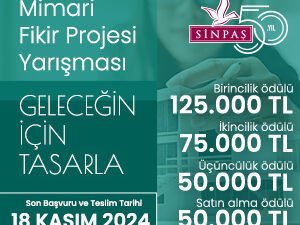- 16 Ağustos 2022
- 13533 defa okundu.
Seoul 100-year Masterplan Exhibition Idea Competition
“Seul 100 yıllık master planını yeşil ağ ile ilişkilendirmek” teması altında gerçekleştirilecek olan “Seoul 100-year Masterplan Exhibition Idea Competition” için başvurular 26 Ağustos - 15 Eylül 2022 tarihleri arasında yapılabilir. Yarışma kapsamında Seul'ün dağlar, nehirler gibi benzersiz doğal topografyasını ve özelliklerini dikkate alan ve toplam yedi yarışma alanına odaklanan çevre dostu ve yüksek yoğunluklu şehrin geleceği için fikirler önerilmesi bekleniyor.

About the Competition
South Korea’s capital was relocated to Hanyang (present-day Seoul) in the 1390s. Seoul has grown and developed with a focus on economic efficiency throughout the process of modernization. On the flip side, the city has become more cut off from the benefits provided by Mother Nature featuring its mountains, streams, winds, etc.
At the 4th (2023) Seoul Biennale of Architecture and Urbanism, it is hoped that this open competition will serve as an active forum in which participants discuss how to overcome the relevant obstacles.
Since the late 1950s post-Korean War period (1950-1953), Seoul Metropolitan’s administrative zones have been expanded with a population boom associated with the rapid expansion of the city. Plans for the city’s urban development were focused on expansion of roads and supply of housing along with the development of technologies, which has led to elements of nature being overlooked in comparison. Seoul offers unique elements of nature that not present elsewhere in the world including Europe and the U.S., and these are precious heritage that we must preserved and passed down for future generations to appreciate. Many urban planners and architects point to the destruction of cities due to unfettered and haphazard development, but there are no comprehensive responses or custom-tailored plans prepared to improve the situation.
Many factors are intricately entangled with each other as to urban planning of Seoul City, making it not easy to draw a plan. That being the case, we intend to formulate a basic roadmap for an idealistic and eco-friendly city through the Seoul Biennale of Architecture and Urbanism, and establish a sound basis for an urban plan geared to Seoul for the next 100 years based on it.
It is not realistic to attempt to set a short-term urban for the entire city of Seoul. Thus, we plan to engage in a ‘study’ by selecting some major urban spaces with respect to the characteristic elements that Seoul retains through this open competition. If helpful and intelligent ideas can be provided for the Hangang River to flow through the city and villages close to the mountains, they can equally be applied to other cities with similar characteristics. As such, this open competition will serve an opportunity to regain Seoul’s original identity, while reconfiguring it as a futuristic city, and unveiling its environmental/ topographical features to the fullest.
Eligibility
- No specific limitations(regardless of nationality or age)
- Any group or an individual can take part
- Participants can be an architect, architectural designer, urban planner, researcher, writer, artist, critic, student, or a corresponding group, but not restricted to one of the above professions
- The members of a participating team should not number more than 10, including individuals and institutions
- A participating team should designate a team leader that will represent it and serve as the representative in charge during the entire process. The team members shall provide their consent that all legal rights/ obligations shall be exercised by the leader
- Each participant may only take part in one of the types (TYPE A ~ G). No one is allowed to submit more than one proposal concerning a category
Timetable
- Open competition period : Jul. 18 – Sep. 15, 2022 (60 days)
- Submission period : Aug. 26 – Sep. 15, 2022, 16:00
- Screening period : Sep. 26 – Sep. 30, 2022
° Announcement of screening result : Oct 14, 2022Timetable is based on Korean Standard Time
° Details of timetable are subject to change, depending on circumstances
To find the full competition brief and register, please visit the competition website.






